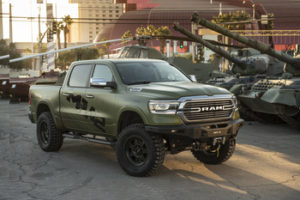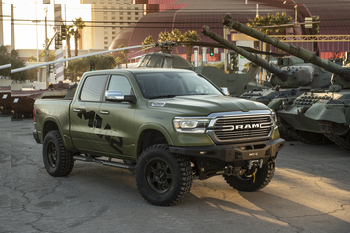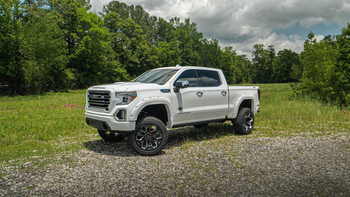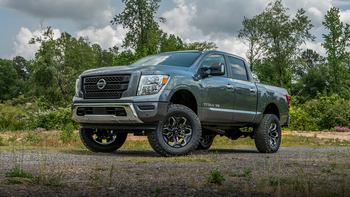
SEMA guest column: Case studies in modifying ADAS-equipped vehicles
By onAssociations | Business Practices | Education | Repair Operations | Technology
Editor’s note: For a collision repairer, the goal is to restore a vehicle to proper OEM tolerances. Failure to do so might alter the effectiveness of advanced driver assistance systems. But what happens when an automotive professional and customer intentionally seek to alter the vehicle’s specifications by installing modifications like a lift kit? Must ADAS functionality be sacrificed?
The Specialty Equipment Market Association recently examined efforts by its members to successfully modify vehicles but preserve the capabilities of the potentially life-saving technology. SEMA has graciously agreed to let us reprint these case studies, which illustrate ADAS considerations for collision repairers and modders and present examples of companies who embraced the challenge of getting it right.
The emergence of advanced driver-assistance systems (ADAS) has been a boon to automotive consumers. Among other benefits, ADAS is credited with a 1.2% drop in vehicle fatalities last year, along with significantly reduced injuries. What’s more, consumer comfort with these technologies is increasing as OEMs build ADAS into an expanding number of vehicle platforms. The result is a growing aftermarket customer base that expects specialty-equipment products and modifications to integrate seamlessly with their high-tech factory ADAS packages. But is the industry up to the task?
Those who attended the Live Across America: SEMA Detroit Virtual ADAS Forum on June 18, 2020, would be optimistic that the answer would be a yes, as four examples of successful customizations and vehicle builds were presented. The forum, now available for viewing at www.semagarage.com/virtualadasforum, brought together a live panel of SEMA manufacturers, industry leaders and technology experts to address the immediate challenges SEMA members are confronting, along with the latest innovations driving the aftermarket toward full ADAS compliance.
Built around actual SEMA manufacturing member case studies of successful product development and vehicle modifications, the forum’s goal was to help SEMA companies customize with confidence by explaining how ADAS technologies and sensors function and how aftermarket products might impact the operation of those safety features. The forum drew more than 500 online attendees from across the United States and as far away as Australia and the United Kingdom, including several OEMs and media.
“This virtual event demonstrated a new way for attendees to engage and learn as we move forward to the ‘next normal.’ This was not just another webinar but an innovative virtual event live-streamed across the country that offered our participants a new way to engage and learn,” said SEMA Vice President of Vehicle Technology John Waraniak, who organized the virtual conference. “The forum included an overview of ADAS technologies, presentations of SEMA partnerships, technology collaborations, frontline best practices and ADAS resources available through these new SEMA Vehicle Technology service offerings.”
According to Waraniak, understanding ADAS systems and how they operate will be an integral part of future aftermarket product development, since accessories such as bumpers, grilles, suspension lifts and even windshield glass can all adversely affect ADAS components.
“The goal wasn’t to make forum participants on-the-spot ADAS experts but to address immediate challenges that SEMA members are encountering due to ADAS technologies,” Waraniak said. “We sought to present the latest information, guidelines, tools and resources to help members customize with confidence as well as innovate and ensure their products, accessories and vehicle builds can be successfully integrated with the latest factory-installed ADAS technologies.”
As vehicles move toward greater autonomy, OEMs have introduced an array of safety-performance technologies under a variety of names, prompting industry organizations—including SAE—to push for a standard nomenclature for the systems. Currently, all of the technologies are divided into two main categories: passive and active. Passive ADAS features give a visual, audible or haptic warning when a collision or unsafe condition is imminent. Active systems take some level of automated control over a vehicle to help mitigate an accident.
Up to now, aftermarket contributions to the ADAS market have mainly been in the form of passive systems. Still, aftermarket ADAS is a fast-growing category that is currently valued at just under $1 billion and is projected to top more than $1.5 billion by 2021. Whether active or passive, ADAS subcategories commonly break down as follows:
- Forward collision avoidance: Forward-collision warning, automated emergency braking, integrated emergency intervention.
- Lateral collision avoidance: Lane-departure warning, blind-spot warning, lane-keeping assistance, lane centering.
- Automated performance enhancements: Antilock braking systems, traction control, electronic stability control and related specialty applications.
- Parking assistance: Passive parking assistance, automated parking assistance, autonomous valet.
- Advanced cruise control: Adaptive cruise control, cooperative adaptive cruise control, partial automation.
- Driver vision augmentation: Advanced headlights, infrared night-vision display, head-up display.
- Connected-vehicle technology: Dedicated short-range communication, commercial cellular, other communication technologies.
“These technologies are the gateways for a lot of the newer technologies that OEMs are deploying today in their vehicle platforms, so we have to get them right and understand them if we’re going to continue to do safe, complete vehicle modifications and repairs,” Waraniak said. “As OEMs introduce more and more automated and autonomous technologies, we’ll see the most complex hardware and software applications ever deployed in automobiles. These systems comprise the most disruptive technologies that automakers have ever initiated.”
The forum included an overview of the new SEMA/I-CAR ADAS Baseline Resource Program as a first go-to resource for members, as well as a Q&A segment that addressed members’ concerns about modifications encompassing larger wheels and tires, bumpers, grilles and lift kits, and paint and other accessories. Issues of cybersecurity, new digital vehicle architectures and over-the-air software updates were also touched on, along with the resources that can help smaller manufacturers compete in product research and development. But the live-stream wasn’t focused on challenges only.
The panel of experts also addressed the many new opportunities that the ADAS category is opening for aftermarket companies, with the following case studies highlighting the industry’s ongoing innovation:
Case Study 1: AEV JL370 2020 Jeep Wrangler
American Expedition Vehicles (AEV) set out to test its ADAS prowess with its AEV JL370 project vehicle, which was built on the 2020 Jeep Wrangler JL platform.
Developed from the ground up, the Jeep is modified with a host of AEV products, including LED off-road lighting; a new front bumper with integrated skidplate, winch and light bar; a new front differential cover; AEV Borla Dualsport wheels with BFGoodrich 37-in. tires; and a snorkel for deep breathing.
In the rear, the Jeep was outfitted with a new bumper and auxiliary light; an updated rear differential; an all-new tire carrier, AEV CHMSL and camera relocation, and the addition of splash guards.
“Just about every product listed will have some sort of an impact on any factory-installed ADAS equipment, and we need to make sure that these products don’t interfere with those features before we release them to market,” said John Natoci, chief operations officer of AEV and one of the conference’s lead presenters. “In order to do that, we need to start early in the design cycle. Before we can put pen to paper, we first need to understand how the vehicle is equipped from the factory. The Wrangler isn’t the most sophisticated when it comes to advanced technology, but the current model does have a pretty decent suite of ADAS equipment.”
 That collection of factory safety features includes front and rear parking assistance, a rear-vision system, automatic high-beam headlamps, adaptive cruise control (ACC), forward collision warning (FCW) and blind-spot monitoring.
That collection of factory safety features includes front and rear parking assistance, a rear-vision system, automatic high-beam headlamps, adaptive cruise control (ACC), forward collision warning (FCW) and blind-spot monitoring.
“Even the smallest changes can have a really big effect,” Natoci observed. “New bumper geometry, modified wheel offset that increase curb heights—all of that needs to be considered as we get into the design phase.”
During initial R&D, AEV’s product developers closely compared their new-design bumpers to the factory originals to identify the new ADAS sensor locations that would require validation. Using field-of-view cones in CAD software, AEV was able to see how the new sensor locations would view the world, along with any interference the bumpers might cause. For the front bumper, developers also considered how winches, tow hooks and other accessories might change or hinder sensor operation. Once the CAD designs checked out, product development moved into physical testing with full vehicle mockups.
“Like a lot of companies nowadays, we use 3-D printing, which allows us to do multiple design iterations and adjust as we go,” Natoci explained. “The data we get from this [mockup] exercise is compared to the baseline data collected on the stock vehicle.”
He added that alterations in tire diameter, tire pressure and rear gear ratios can also factor into ADAS compliance. During the physical testing phase, AEV partnered with several third parties to perform proving-ground testing that the company was unable to perform in-house. Final inspection included technicians plugging into vehicle systems using MOPAR software to completely scan ADAS equipment and verify calibration and compliance.
In the end, AEV’s careful research and development and real-world testing paid off. The company was able to recalibrate and verify compliance of the fully modified Wrangler’s ADAS features. AEV also makes a ProCal Snap tool available to its customers to help them maintain their vehicle’s compliance, knowing that many of them continue to modify their vehicles over time.
“All our modified vehicles include a Snap, and we also include one with every suspension system,” Natoci said. “Since we work across multiple OEMs and multiple vehicle platforms, we’re committed to making sure that all of our new products are compliant with ADAS as they come out, and we look forward to keeping up with this new technology as it grows.”
Case Study 2: The Transamerican 4WP 2019 Ram 1500
As another case study in successful modification of an ADAS-equipped vehicle, Transamerican 4WP presented its 4WP 2019 Ram 1500 truck to conference participants.
“We jumped on the opportunity last year to get on this ADAS adventure, as we call it, because we not only develop house brands, suspensions and accessories that we want compliant and safe, but we also outfit thousands of vehicles a month through our 95 store locations using third-party brands,” said Kris Hernandez, director of suspension engineering for Transamerican 4WP.
The Ram truck’s factory systems included ACC; adaptive LED headlights; advanced braking assistance and FCW; advanced cameras and sensors, including a 360-degree camera; blind-spot protection; front and rear parking sensors; and lane-departure features.
For its project build, 4WP opted for a modification package typically favored among the company’s consumers. The truck received a Pro Comp 6-in. Suspension system, Pro Comp 37-in. Extreme Mud Terrain tires, Pro Comp 20×9-in. wheels, Smittybilt front and rear bumpers, and Smittybilt side steps.
Hernandez noted that introducing products for newer-model vehicles can be a challenge nowadays.
“Technology changes quickly, and OEMs are not readily handing out support to the aftermarket, so it takes a new approach and some additional steps on the development side,” he said.
According to Hernandez, the company’s end goal is always OEM equivalency of aftermarket parts and components.
“As we develop accessories for each new platform manufacturer, we need to start with some basic evaluations,” he explained.
That means acquiring all available OE data on a given vehicle’s systems, along with lots of actual road time to fully understand their operation.
“Our evaluations are performed on a documented local test loop, with all typical scenarios and road types,” he said. “On top of the standard test-loop evaluations, we perform two extended evaluations from our R&D facility in San Diego to our corporate facility in Los Angeles during typical California traffic. For this particular Ram 1500, the long-distance evaluation was accomplished on the freeway, with no brake or accelerator input once radar cruise was activated. If you know California traffic, you know that is a pretty convenient feature, to say the least. The Ram system is probably one of the nicer-performing systems that I’ve developed product for.”
Like other aftermarket product designers, 4WP also utilized sensor cone data in its CAD design phase. Once parts were ready, they were fitted on the vehicle, and all the prior drive tests were duplicated to make sure that the data matched the original performance baselines.
“Testing and mapping is repeated, and corrections are made until the systems meet the OE range measured when the vehicle was first delivered to us 100% stock,” Hernandez said, adding that 4WP routinely clocks 300 to 500 mi. in its drive evaluations.
In addition to road testing, the Ram also underwent detailed evaluation by asTech, which specializes in remote diagnostic scanning and ADAS calibrations for repair shops.
“There were a lot of things we learned on the Ram truck,” said asTech Director of Industry Relations Jake Rodenroth. “It’s a little bit different than some of the other vehicles we’ve seen. The integration of sensor fusion, where you’ve got sensors working as a team, is very true in the Ram’s case, so you have a radar and a camera system mounted in the windshield. In a lot of other vehicles we see, the radar is typically lower in the vehicle, behind a grille or a bumper cover.
“The higher mounting in the Ram’s case presents challenges. On the other hand, the system is much more forgiving in regard to the height of the vehicle. You make a measurement from the top of the tire to the bottom of the fender and enter that value into the scan tool, then go through the dynamic calibration process. We were successful in getting this vehicle to validate with the modifications placed onboard.”
In the end, asTech determined that the new suspension lift height calibrated within the Ram’s prescribed range. The wheel offset also proved compatible with the truck’s stability control features, and the front and rear bumpers and side steps properly accommodated the vehicle’s perimeter sensors and intelligent headlights. The vehicle now continues to serve as a testbed to ensure that other new 4WP products function at stock equivalency and don’t throw any codes.
Case Study 3: Fox Factory SCA Performance 2020 GMC Sierra 2500
Michael McSweeney, president and general manager of SCA Performance Division for Fox Factory, said that his company has built successful development partnerships with General Motors, Ford, Chrysler and Nissan.
“Out of our four manufacturing plants, we’re currently upfitting about 1,000 lifted trucks per month, all of which end up being sold through new-car dealerships,” McSweeny explained. “It’s truly essential to our business model for our vehicles to not only meet Federal Motor Vehicle Safety Standards [FMVSS] but also be on the leading edge of adapting our upfits to new ADAS features, because they’re becoming a standard part of each vehicle. We need to assure our end users, our OEM partners, the dealers who retail our vehicles, and the insurance companies who are insuring our drivers that all of our modified vehicles continue to perform at a high level even after we modify the vehicle.”
In this case, the company turned to a ’20 GMC Sierra 2500 to prove its abilities—a special challenge given the vehicle’s sophisticated “Safety Package 2,” which includes the ability to automatically brake for pedestrians.
Modifications for the Sierra included a 6-in. BDS suspension lift system, 22-in. wheels, and 35-in. all-terrain tires. After an alignment to factory specs and a calibration of its steering-angle sensor, the big GMC was hooked up to a Cardaq 3 Plus device with GMC GDS 2 software for dynamic calibration. That put the vehicle into learn mode, and a calibration test drive followed.
While that may sound straightforward enough, McSweeny said there were a lot of layers to the process.
“Since the ADAS features really work as a big network getting information from other systems in the vehicle, there are some fundamental calibrations that need to be done even prior to focusing on the camera and the radar systems,” he said. “Those things include speedometer calibrations to account for larger tire sizes, four-wheel alignment, steering angle sensor alignment, FMVSS 126 and 135 testing so that we can ensure that the vehicle is braking and the electronic stability control systems are all performing like they should.”
After SCA Performance’s road tests were completed, all the data indicated functional compliance.
“But since this was a new thing, we didn’t really think we could roll out our own validation,” McSweeny said. “So we decided to send the truck out to the Transportation Resource Center [TRC] in Ohio for them to actually put the truck through the Insurance Institute for Highway Safety [IIHS] pedestrian autonomous emergency braking test, along with some additional testing on the adaptive cruise control system.”
TRC is among the most advanced independent mobility testing service providers in North America. Its Ohio facilities and proving grounds cover 4,500 acres and include a 7.5-mi. automotive testing track. To test AEB for pedestrians, the center utilizes walking robots that imitate the movements of both adults
and children.
As TRC ADAS Test Lead Blaine Ricketts explained, IIHS evaluations normally involve three pedestrian scenarios—one with an adult crossing a road perpendicularly, another with a child emerging perpendicularly from two obstructing vehicles, and a parallel adult facing away in the roadway. The testing equipment also includes a throttle robot inside the vehicle, along with a camera and microphone to “see and hear” visual and audible alerts. GPS is also employed to gather position, speed and ground-truth data.
Being very low to the ground, the child robot presented a unique test for the lifted Sierra. Nonetheless, the modified truck ultimately aced its exam with high marks. All the ADAS systems calibrated—and validated—as required.
Case Study 4: Fox Factory SCA Performance 2020 Nissan Titan
According to McSweeny, when SCA Performance first began testing products on ADAS-equipped platforms, the company started with the ’20 Nissan Titan.
“The reason we chose the Titan was that it was actually the first OEM model to feature automatic braking technologies in all its trim levels,” McSweeny said. “We’re very grateful to our friends at Nissan for allowing us to have a vehicle to do some testing on.”
The Titan received a BDS 6-in. suspension lift system, 20-in. wheels and 35-in. BFGoodrich all-terrain tires, along with an alignment to factory specs.
The Titan’s ADAS features call for static verification, meaning that the truck had to be positioned within certain target floor parameters. Calibrating the truck’s forward-facing cameras also required setting up static targets per Nissan specs, including wheel-mounted lasers and framework for radar calibration. The project crew relied on asTech hardware and calibration software to communicate remotely with a dedicated technician and run a finalized DTC check to ensure that no codes were thrown. Once all those steps were accomplished, the vehicle was cleared for test drives.
During on-road testing, the Titan’s lane-departure warning and adaptive cruise control with gap adjustments were validated. Once the truck received its VIN-specific calibration documentation, it was off to TRC for further proving-ground evaluation, including FMVSS 126 testing.
“From an ADAS standpoint, calibrating the Nissan Titan truck was quite a bit different from the tests we went through on the GMC Sierra,” McSweeny said. “The GMC is a dynamic system, and the Nissan is a static system, so the pathway that we take to calibrate is much different. The ’20 Nissan Titan that we tested was equipped with both the radar system and the forward-facing camera system mounted behind the rearview mirror. We partnered with asTech to help us navigate [procedures] and build a standard process to calibrate the Titan.”
AsTech’s Rodenroth added that static systems such as Nissan’s call for careful vehicle prep to ensure proper ADAS calibration. That can include seemingly meticulous details such as maintaining specified fuel levels and tire pressures and even clean windshields.
“It’s critical that you review [OEM requirements] for every model, because you could have differences between them,” he explained.
As for TRC’s role in the process, Ricketts said that it’s gratifying to help product manufacturers create best practices for developing ADAS-compatible parts and accessories.
“As companies do aftermarket modifications, one of the best ways of performing validation is through on-pavement testing,” he added.
The SEMA Detroit ADAS Forum and Vehicle Review demonstrated the rapid innovation that is taking place in the aftermarket to embrace new-vehicle technologies. Many automotive segments are coming together to promote common goals, develop standard R&D procedures for products, and create standard operating procedures for proper calibration and validation of ADAS functionality in vehicles modified by aftermarket components. It’s a costly endeavor at times, but it’s worth the price.
“If you’re going to modify a vehicle in today’s world, safety has got to be the top priority,” McSweeny explained. “We didn’t really sit down and ask if we want to make these investments or if we want to push them off and maybe cut a corner and not do them. We had to do it.
“Figuring out the pathway to do it, who to partner with and who can provide us with the education and technology to know what to do on each model—that was probably our biggest hurdle. Our opinion and our mindset on the topic in general is let’s develop these processes and standards, let’s collaborate even with our competitors, and let’s give this information to the industry, because it’s really essential for everyone to be doing this.”
Waraniak was quick to underscore the widespread cooperation among the industry’s biggest players and the sharing of data and best practices with the little guy. To that end, SEMA and other automotive associations continue to partner to offer shared resources and tools to all SEMA members. As Waraniak summed up, “Everyone believes we have to get this right. Our industry’s future depends on it.”
Further information relating to the SEMA Detroit ADAS Forum and Vehicle Review, including a link to the full video presentation, can be found online at semagarage.com/services/virtualadasforum.
Michael Imlay is an executive editor for the the Specialty Equipment Market Association.
More information:
“Modifying ADAS-Equipped Vehicles”
SEMA, October 2020
“SEMA Detroit ADAS Forum and Vehicle Review” resources
SEMA, June 18, 2020
“Live Across America: SEMA Detroit Virtual ADAS Forum and Vehicle Review – June 18, 2020”
SEMA Show YouTube channel, June 18, 2020
Images:
Transamerican 4WP validated advanced driver assistance systems on a 2019 Ram 1500 upon which it had installed one of its popular modification packages. (Provded by SEMA)
American Expedition Vehicles validated advanced driver assistance systems in a JL370 2020 Jeep Wrangler project vehicle modified for offroading. (Provided by SEMA)
Fox Factory’s SCA Performance Division confirmed that this lifted 2020 GMC Sierra 2500 still automatically brakes properly for pedestrians. (Provided by SEMA)
Fox Factory’s SCA Performance Division was able to calibrate advance driver assistance systems on this lifted 2020 Nissan Titan. (Provided by SEMA)



